Bdelloid Rotifers: 80M Years Without Sex Rewrites Evolution
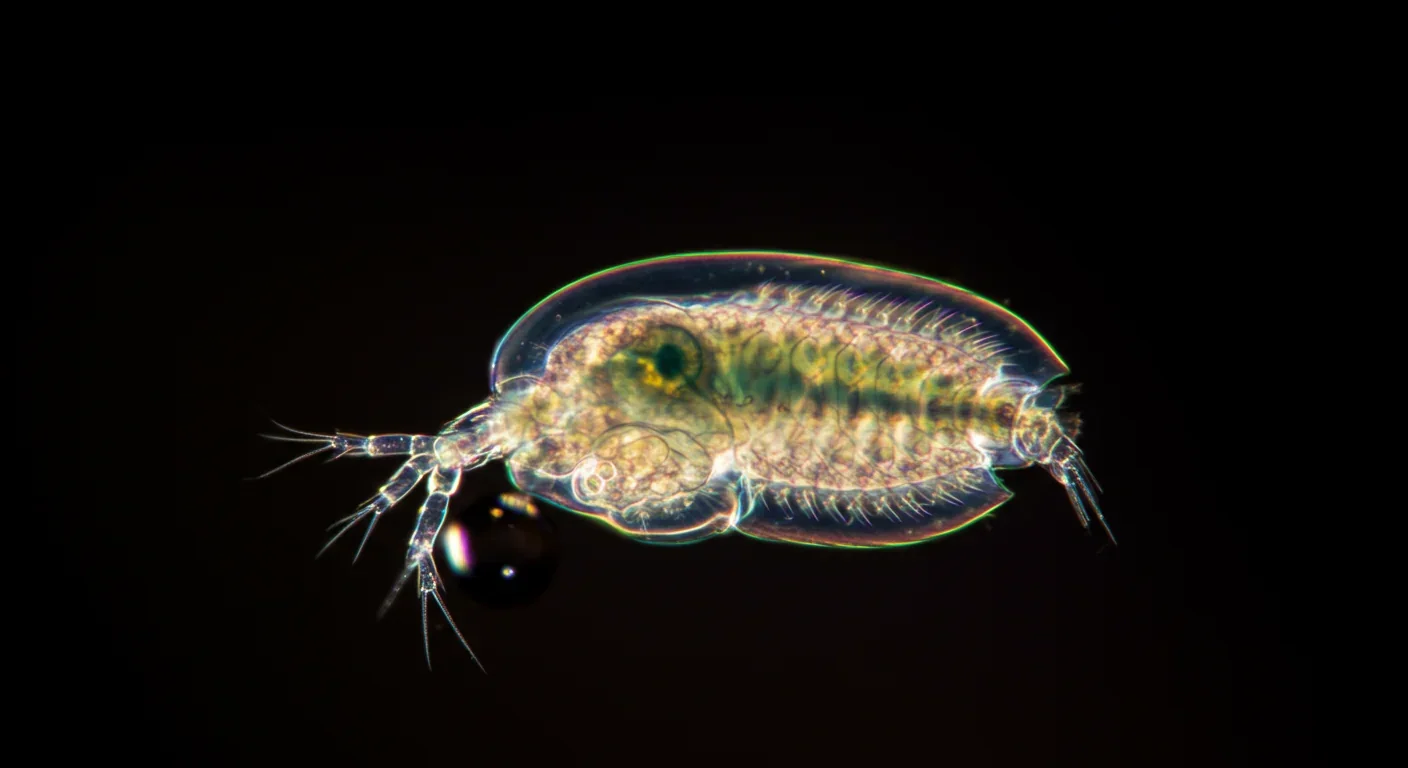
TL;DR: Scientists have decoded how geckos defy gravity using billions of nanoscale hairs that harness van der Waals forces—the same weak molecular attraction that now powers climbing robots on the ISS, medical adhesives for premature infants, and ice-gripping shoe soles. Twenty-five years after proving the mechanism, gecko-inspired technologies are quietly revolutionizing industries from space exploration to cancer therapy, though challenges in durability and scalability remain. The gecko's hierarchical foot structure—500,000 setae per foot, each branching into a thousand spatulae—demonstrates that geometry, not chemistry, is the key to reversible, residue-free adhesion that could reshape robotics, medicine, and manufacturing worldwide.
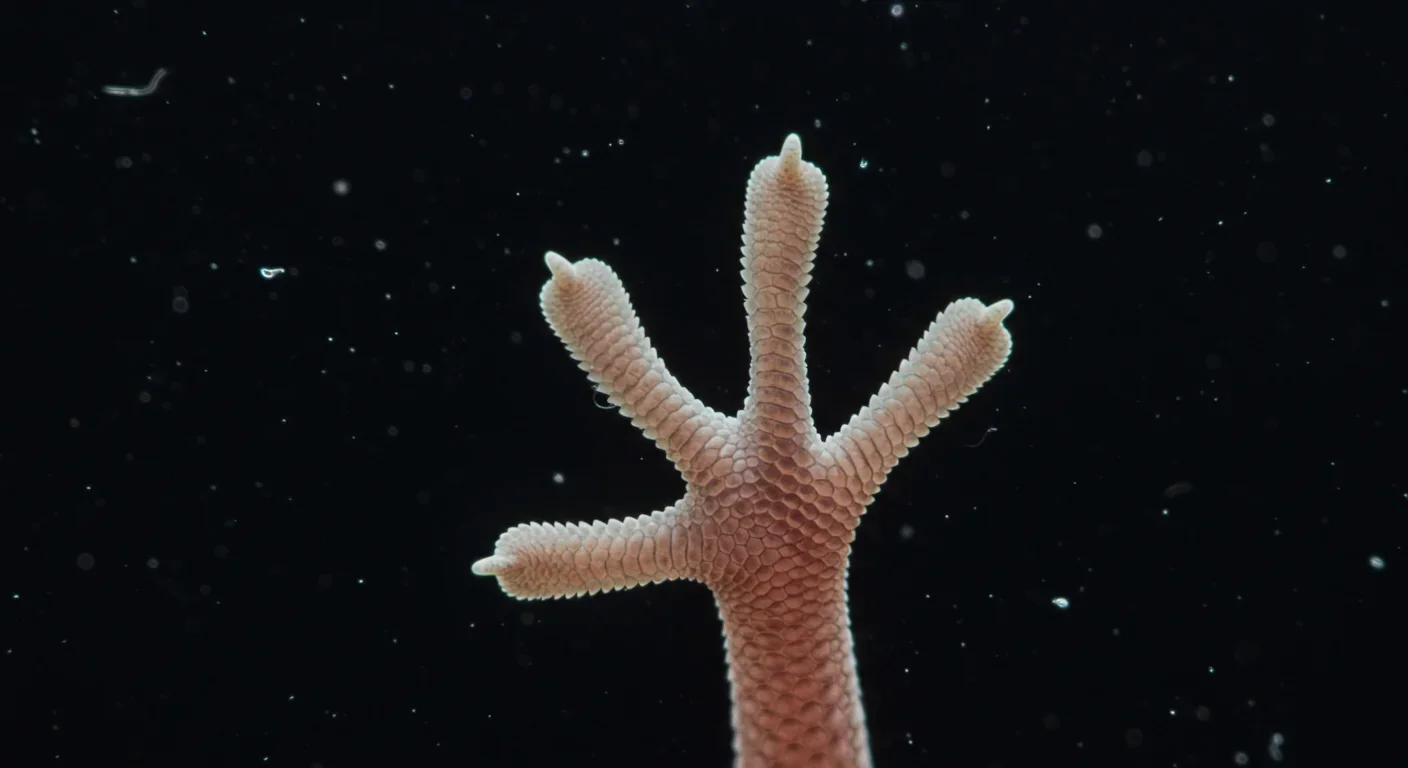
In laboratories from Berkeley to MIT, a quiet revolution has been unfolding—one that began with a simple observation: geckos can sprint upside down across glass ceilings at 20 body lengths per second, supporting forces equivalent to 50 times their body weight, all without a drop of glue. For centuries, this seemingly impossible feat baffled naturalists and physicists alike. How does a five-ounce lizard generate adhesive force equivalent to carrying nine pounds up a wall, then release instantly to take its next step?
The answer, discovered only at the turn of this millennium, has spawned an entirely new field of materials science. It turns out that gecko feet harness one of nature's weakest forces—van der Waals interactions between molecules—and amplify it through a hierarchical structure so elegant that engineers are still struggling to replicate it two decades later. But the implications extend far beyond understanding lizard locomotion. Today, gecko-inspired adhesives are climbing walls on the International Space Station, gripping surgical tools in operating rooms, and may soon line the shoe soles that prevent winter falls or the bandages that heal premature infants without tearing their fragile skin.
This is the story of how we decoded one of evolution's most sophisticated engineering achievements, and how that knowledge is quietly revolutionizing robotics, medicine, space exploration, and even semiconductor manufacturing. The gecko's foot, it turns out, is not just a biological curiosity—it's a blueprint for technologies that could reshape how humans interact with our physical world.
Peer beneath a gecko's toe with an electron microscope and you'll discover a world of almost incomprehensible intricacy. The foot pad is not smooth but covered in parallel ridges called lamellae. Each ridge bristles with approximately 14,400 microscopic hairs per square millimeter—structures called setae, each about 100 micrometers long and five times thinner than a human hair. A single gecko foot bears roughly 500,000 of these setae.
But the real marvel lies one level deeper. Each seta branches into hundreds—sometimes more than a thousand—even tinier structures called spatulae. These spatulae measure a mere 200 nanometers on their longest side and 10-30 nanometers on their other dimensions: roughly one five-hundredth the width of a human hair. Across all its toes, a single gecko may possess up to two billion of these nanoscale contact points. It's this hierarchical branching—from toe pad to lamellae to setae to spatulae—that creates the gecko's superpower.
When a gecko places its foot on a surface, these billions of spatulae come within 0.3 to 0.6 nanometers of the substrate's molecules. At such infinitesimal distances, something remarkable happens: temporary fluctuations in the electron clouds of atoms create fleeting positive and negative charges. These induce complementary charges in nearby molecules, generating a weak attractive force discovered by Dutch physicist Johannes van der Waals in 1873. For any single spatula, this van der Waals force is trivial—about 10 nanonewtons. But multiply it by two billion contact points, and you generate approximately 20 newtons of adhesive force: enough to support more than 20 times a typical gecko's weight.
Researchers quantified this precisely in a landmark 2000 Nature paper. Using micro-electromechanical sensors, Kellar Autumn and Robert Full measured that a single gecko seta generates an average adhesive force of 194 micronewtons—nearly ten times what initial theoretical models predicted. The cumulative adhesive force of all the tiny hairs lining a gecko's toes proved to be ten times greater than the maximum force needed to pull a live gecko off a wall. As Full observed: "A single seta can lift the weight of an ant. A million setae, which could easily fit onto the area of a dime, could lift a 45-pound child."
For millennia, gecko adhesion remained firmly in the realm of folk wisdom and speculation. Aristotle noted their climbing prowess; medieval naturalists proposed suction cups or sticky secretions. Even into the twentieth century, hypotheses ranged from microscopic hooks that interlocked with surface irregularities to electrostatic cling generated by friction.
The breakthrough came in stages. In the 1950s and 60s, electron microscopy revealed the intricate structure of setae and spatulae, but the mechanism remained elusive. Some researchers suspected capillary adhesion from moisture; others proposed friction alone could account for the grip. The decisive moment arrived in 2000, when Autumn, Full, and their colleagues at UC Berkeley published direct experimental evidence. By isolating individual setae and testing them on hydrophobic and hydrophilic surfaces in controlled conditions, they demonstrated that adhesion remained consistent regardless of surface chemistry or ambient humidity. Capillary forces and chemical bonding were ruled out. Only van der Waals forces fit the data.
Two years later, a 2002 PNAS paper by Autumn, Israelachvili, and others provided definitive proof, combining atomic force microscopy with theoretical modeling via the Johnson-Kendall-Roberts (JKR) equation. Measurements showed that pushing a seta onto a surface and pulling slightly downward increased adhesion 600-fold compared to friction alone—a phenomenon they termed "frictional adhesion." As Autumn declared: "Our new data prove once and for all how geckos stick."
This revelation had immediate implications. In 2001, a collaboration between the Manchester Centre for Mesoscience and Nanotechnology and Russia's Institute for Microelectronics Technology began fabricating synthetic setae from polyimide using electron beam lithography. Results appeared in Nature Materials in 2003. A year later, researchers demonstrated that carbon nanotube arrays could reproduce gecko-like shear adhesion, with results published in PNAS in 2007. The race to create "gecko tape" had begun.
The historical significance of these discoveries extends beyond biomimicry. They revealed a universal principle: van der Waals forces, weak in isolation, become formidable when distributed across vast numbers of nanoscale contacts. As Kellar Autumn put it: "The van der Waals theory predicts we can enhance adhesion—just as nature has—simply by subdividing a surface into small protrusions." Geometry, not chemistry, was the key. This insight has since informed everything from graphene research to the design of micro-electromechanical systems.
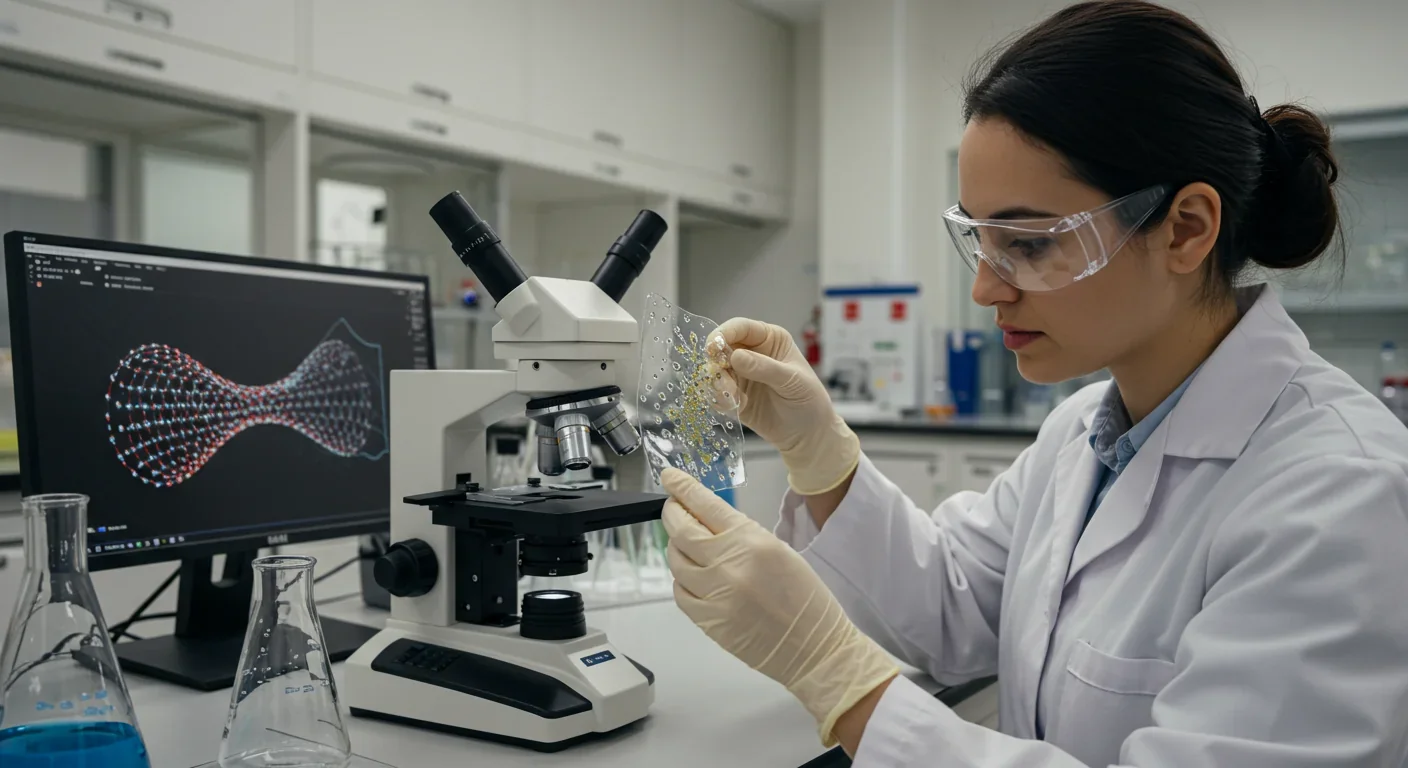
Replicating gecko adhesion in the lab has proven devilishly difficult. Early prototypes using flexible polymer fibers achieved only a fraction of natural performance. The challenge lies not merely in creating nanoscale structures but in reproducing the hierarchical compliance—the ability of setae and spatulae to deform and conform to surfaces at multiple scales simultaneously.
One breakthrough came from the University of Massachusetts Amherst, where researchers developed "Geckskin"—an adhesive that holds 700 pounds on smooth walls using a 16-inch square pad. Paradoxically, Geckskin does not mimic setae at all. Instead, it combines a soft elastomer (polydimethylsiloxane, PDMS) with ultra-stiff fabrics like carbon fiber, creating what the team calls "draping adhesion." The stiff fabric distributes load evenly, while the soft pad maximizes contact area by conforming to surface contours. The result outperforms many attempts to replicate microscopic hairs.
Other approaches embrace nanofabrication directly. Researchers at the University of Akron and Georgia Tech created carbon nanotube arrays that simulate setae. Multi-walled nanotubes, grown in vertically aligned forests, achieve shear stresses of 36 N/cm²—nearly four times stronger than natural gecko feet. The trick lies in the nanotube tips: when pressed onto a surface, the tangled, curly tops align with the substrate, dramatically increasing contact area and maximizing van der Waals forces. Critically, these synthetic adhesives exhibit anisotropic adhesion—strong in shear (parallel to the surface) but easily peeled off in the normal direction, just like gecko toes.
Yet challenges remain. Natural setae are self-cleaning; dirt particles adhere more strongly to substrates than to the hydrophobic setae, so contaminants transfer away with each step. Synthetic versions often lack this property. Moreover, carbon nanotube arrays tend to break under repeated use rather than releasing cleanly, limiting reusability. As one study noted: "When pulled parallel to a surface, the tape releases, not because the CNTs lose adhesion from the surface but because they break, and the tape cannot be reused."
A third strategy leverages surface chemistry alongside structure. In 2022, NIST scientists discovered that gecko setae are coated with a one-nanometer-thick lipid film, arranged in dense, orderly arrays. These lipids repel water, preventing a lubricating liquid layer from forming between spatulae and wet surfaces. Inspired by this, researchers developed gecko-inspired adhesives enhanced with hydrophilic nanoparticles for icy conditions. Silicone rubber compounded with 3-5% zirconia nanoparticles, then laser-etched to create microfibrillar grooves, absorbs the quasi-liquid layer on ice surfaces. The water freezes inside microcavities upon contact, generating mechanical interlocking—capillary-enhanced adhesion that resists slips while still allowing easy detachment.
These diverse approaches underscore a central insight: there is no single "correct" way to mimic gecko adhesion. Success depends on matching design strategy to application. Soft, compliant materials excel on rough surfaces; stiff, structured arrays work best on smooth ones. Anisotropic microstructures enable easy release; isotropic designs maximize holding power. The gecko's genius lies in integrating all these principles into a single, multi-scale system.
The societal transformation potential of gecko-inspired adhesives spans industries that touch billions of lives. Consider robotics: traditional climbing robots rely on suction cups, magnets, or mechanical grippers, each limited to specific surfaces or conditions. Gecko adhesives work on glass, metal, painted walls, rough concrete, even in vacuum. NASA tested gecko-inspired grippers on robots designed to capture space debris in 2024, demonstrating that the technology functions in extreme temperatures, zero gravity, and airless environments. As Aaron Parness of NASA's Jet Propulsion Laboratory noted: "Gripper hands could repair satellites or help tiny CubeSats hitch rides on larger craft."
On Earth, gecko-inspired robots are already deployed in disaster response. Stanford's "Stickybot," developed in the 2010s, climbs vertical surfaces to search earthquake rubble for survivors. More recent designs integrate soft robotics with gecko adhesives, creating grippers that combine adaptability with strong adhesion. A 2018 University of California San Diego team built a pneumatic gripper embedding gecko-inspired microstructures within high-strength fabric. The result: a soft robotic hand that lifts 45 pounds, handles delicate objects without damage, and grips rough surfaces traditional soft robots cannot manage. As first author Paul Glick explained: "These two components, soft robotics and gecko adhesives, complement each other really well."
Medical applications may prove even more transformative. Current surgical tapes and bandages use chemical adhesives that damage fragile skin—a serious problem for premature infants, burn victims, and the elderly. Gecko-inspired adhesives offer a solution: strong attachment without residue, repeatable bonding, and compatibility with wet biological surfaces. Alyssa Stark, whose lab at Villanova studies gecko adhesion for medical use, emphasizes the versatility: "They have an adhesive system that works over and over again on a variety of surfaces in a variety of contexts." Early prototypes of reusable wound dressings and surgical tapes have been tested on human skin, achieving secure attachment with minimal tissue trauma.
An even more audacious medical application emerged in 2025: gecko-inspired cancer therapy. Researchers at the University of Colorado developed biodegradable polymer particles (PLGA) displaying branched, hair-like nanostructures that mimic setae. These particles cling to bladder tumors for days, even in the slippery urinary environment, slowly releasing chemotherapy drugs directly at the cancer site. In animal trials, the adhesive particles remained attached far longer than conventional drug carriers, enabling sustained local treatment while minimizing systemic side effects. As lead author Jin Gyun Lee explained: "We envision that this gecko-inspired technology could ultimately reduce the frequency of clinical treatments, potentially allowing patients to receive fewer but longer-lasting therapies."
Industrial manufacturing is another frontier. Semiconductor fabrication uses ceramic chucks to hold delicate silicon wafers during processing. These chucks generate particle contamination and wear over time, reducing yield. Michael Varenberg at Georgia Tech demonstrated that wall-shaped microstructures molded from polyvinylsiloxane—mimicking gecko toe geometry—can replace ceramic chucks. The gecko-inspired surfaces attach at 60-90° and detach at zero force when tilted to 140-160°, eliminating wafer damage and extending tool life. Varenberg notes: "Using gecko adhesion microstructures instead would be better because they do not generate any damage to wafers and do not wear over time."
Consumer products are emerging, too. Setex Technologies commercialized gecko-inspired anti-slip materials after 15 years of R&D, embedding thousands of patented microfibers into phone mounts, dashboard grips, and yoga mats. Gecko tape—double-sided adhesive based on carbon nanotubes—is sold for hanging lightweight items on smooth walls without leaving residue. While performance remains below industrial-grade gecko adhesives, these early products hint at a future where residue-free, reusable adhesion is ubiquitous in daily life.
Yet for all its promise, gecko-inspired technology confronts formidable barriers to widespread adoption. Durability remains a persistent problem. Natural gecko setae endure tens of thousands of attachment-detachment cycles; synthetic versions often fail after hundreds. Carbon nanotube arrays, despite their superior shear strength, break rather than release cleanly. Polymer microstructures foul more easily than biological setae, losing effectiveness when contaminated by dust or oils. As one review noted: "Synthetic and natural materials could be re-used up to 30,000 times without losing their stickiness"—but achieving that reusability in practical synthetic systems has proven elusive.
Manufacturing scalability poses another obstacle. Fabricating billions of nanoscale structures across large surface areas demands advanced techniques like electron beam lithography, chemical vapor deposition, or precision molding—all expensive and time-consuming. Geckskin sidesteps this by avoiding nanofabrication entirely, but sacrifices some of the versatility that hierarchical structures provide. The trade-off between performance and production cost remains unresolved.
Environmental sensitivity complicates deployment. While gecko adhesives work across a range of conditions, performance degrades on extremely rough surfaces (where spatulae cannot make sufficient contact) and on ultra-low-energy materials like Teflon (where van der Waals forces are too weak). Temperature extremes can alter polymer compliance, and prolonged UV exposure degrades many candidate materials. For space applications, engineers must select polymers that withstand vacuum, radiation, and thermal cycling—a narrow material palette.
Ethical and social concerns also loom. As gecko-inspired grippers grow more capable, questions arise about surveillance and privacy. Wall-climbing robots equipped with cameras could enable unprecedented intrusion into private spaces. Who regulates their use? In medical contexts, adhesive particles that cling for days inside the body raise questions about long-term biocompatibility and removal. What happens if the adhesive does not degrade as expected, or triggers an immune response?
Moreover, the technology risks exacerbating inequality. Advanced gecko adhesives, produced via cutting-edge nanofabrication, will initially be affordable only to wealthy institutions—universities, defense contractors, elite hospitals. If gecko-inspired surgical tapes reduce infection rates but remain too costly for low-income clinics, health disparities widen. Similarly, gecko-based robotics might displace human workers in inspection, maintenance, and rescue roles, concentrating economic benefits among those who own the robots while leaving displaced workers without alternative livelihoods.
There is also the risk of unintended ecological consequences. If gecko-inspired adhesives become ubiquitous in consumer products, disposal and degradation pathways matter. Nanostructured materials, particularly those incorporating carbon nanotubes or metal nanoparticles, could accumulate in landfills or aquatic ecosystems. The long-term environmental fate of these materials remains poorly understood.
Gecko adhesion research is inherently international, with laboratories across North America, Europe, and Asia contributing pivotal discoveries. The 2003 synthetic setae breakthrough emerged from a UK-Russia collaboration. German researchers at the University of Kiel developed early gecko tapes, demonstrating that a 20 cm x 20 cm patch could support a researcher hanging from the ceiling. Japanese teams have explored hybrid approaches combining gecko adhesion with other biomimetic strategies, such as octopus-inspired suction.
China has invested heavily in soft robotics and gecko-inspired grippers, viewing them as strategic assets for manufacturing automation and space exploration. The 2023 GeiwBot—a gecko-inchworm hybrid climbing robot developed at the University of Waterloo—exemplifies this trend, using liquid crystal elastomers and magnet-enhanced adhesive pads to climb walls untethered. The robot's designers envision surgical assistance and search-and-rescue applications, sectors where China seeks technological leadership.
Meanwhile, American institutions dominate fundamental research and high-profile applications. Stanford, UC Berkeley, Georgia Tech, MIT, and NASA's Jet Propulsion Laboratory have collectively produced much of the foundational science and many of the most advanced prototypes. DARPA funding has driven military and space applications, including grippers for satellite servicing and inspection robots for naval vessels.
European researchers emphasize sustainability and medical applications. Scandinavian teams study the role of surface chemistry—such as the lipid coatings discovered by NIST—and pursue biodegradable gecko-inspired adhesives for healthcare. This reflects broader European priorities around green technology and patient-centered medicine.
Yet international collaboration coexists with competition. Patents on gecko-inspired technologies are proliferating, and some countries view adhesive robotics as dual-use technologies with military implications. Gecko-based grippers could enable stealthy drones, wall-climbing surveillance bots, or autonomous inspection of critical infrastructure. As these capabilities mature, geopolitical tensions over who controls the technology—and how it is used—are likely to intensify.
Cultural attitudes toward biomimicry also vary. Western research tends to frame gecko adhesion as an engineering problem to be solved with synthetic materials. East Asian approaches, influenced by longer traditions of learning from nature, sometimes integrate gecko principles more holistically, blending them with other biological strategies (like the inchworm locomotion in GeiwBot). African and Latin American researchers, though underrepresented in the literature, bring unique perspectives rooted in local biodiversity and the need for low-cost, locally producible solutions—priorities that could drive future innovation toward simpler, more accessible gecko-inspired technologies.
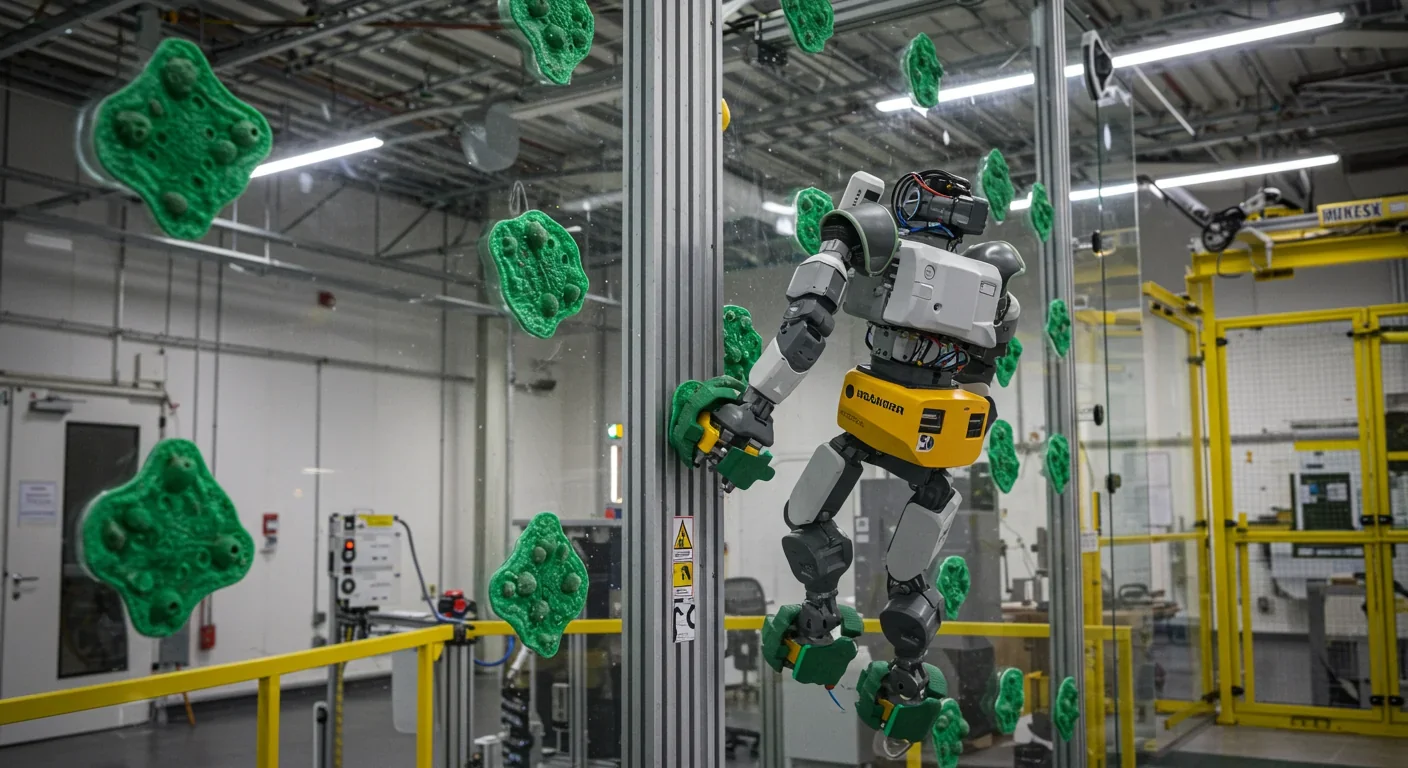
What does it mean for society when sticky tape becomes programmable, when robots can walk on any surface, when surgery leaves no adhesive scars? The gecko-adhesive revolution will unfold gradually, but its effects will be pervasive. For individuals, the most immediate changes will appear in consumer products—phone mounts that never slip, wall hooks that hold hundreds of pounds yet peel off cleanly, winter boots with soles that grip ice without metal spikes. These conveniences will subtly reshape expectations around adhesion: we'll grow accustomed to surfaces that stick on demand and release effortlessly.
Professionally, gecko-inspired technologies will create new roles while transforming existing ones. Materials scientists and roboticists must develop expertise in multi-scale fabrication, surface chemistry, and biomechanics. Medical device engineers will need to integrate adhesive performance with biocompatibility and regulatory compliance. Building inspectors and maintenance workers may increasingly rely on gecko-climbing drones, shifting their work from physical ascent to remote piloting and data interpretation.
For students and early-career professionals, gecko adhesion exemplifies the interdisciplinary nature of 21st-century science. Success in this field demands fluency across physics (van der Waals forces), biology (gecko anatomy and behavior), materials science (polymers, nanotubes, surface coatings), mechanical engineering (compliance, load distribution), and even computer science (controlling adhesive robots). Cultivating such breadth is essential.
At a societal level, we must anticipate both opportunities and dilemmas. Policymakers will need frameworks to govern gecko-inspired robotics—standards for when and where wall-climbing drones can operate, liability rules for adhesive failures in medical or industrial settings, environmental regulations for nanomaterial disposal. International bodies may negotiate treaties limiting military applications, akin to agreements on autonomous weapons.
Public engagement will be critical. As gecko adhesives proliferate, misconceptions and fears could arise—concerns about surveillance robots, anxiety over nanomaterials in consumer products, or mistrust of biodegradable medical adhesives. Scientists and institutions must communicate transparently about capabilities, limitations, and risks, fostering informed public discourse rather than hype or alarm.
Ultimately, preparing for a gecko-adhesive future means embracing adaptability. The technologies emerging today will evolve in ways we cannot fully foresee. Some applications will succeed spectacularly; others will fail or reveal unforeseen downsides. By remaining curious, critical, and collaborative—by learning from both the gecko's evolutionary ingenuity and our own iterative experiments—we can navigate this transformation wisely.
Twenty-five years ago, we finally understood how geckos stick. That revelation has cascaded into a wave of innovation touching space exploration, surgery, robotics, manufacturing, and consumer goods. Yet the gecko's foot still outperforms our best synthetics in versatility, durability, and energy efficiency. Nature's four-hundred-million-year head start remains formidable.
But the deeper lesson is not humility—it's possibility. The gecko teaches us that weak forces, intelligently organized across scales, can generate extraordinary capabilities. Van der Waals interactions, negligible in isolation, become mighty when harnessed by billions of nanoscale contacts. Hierarchical structures—setae branching into spatulae, soft pads supported by stiff tendons—distribute loads and adapt to surfaces in ways no single-scale design can match. And reversible adhesion, toggled by geometry rather than chemistry, enables rapid, energy-free attachment and release.
These principles extend beyond adhesives. They inform how we design materials that are strong yet flexible, surfaces that are sticky yet clean, robots that are powerful yet gentle. They hint at a future where our built environment mimics biology's elegance: structures that self-assemble, systems that self-clean, devices that adapt seamlessly to context.
As gecko-inspired technologies mature, they will fade into the background—a climbing robot inspecting a bridge, a surgical tape sealing a wound, a gripper gently lifting a fragile sensor onto a spacecraft. We will take for granted what once seemed impossible: surfaces that stick without glue, robots that defy gravity, adhesives that leave no trace. And in that quiet ubiquity, the gecko's legacy will endure—a reminder that nature's solutions, decoded with patience and care, can reshape civilization itself.
The gecko's foot is not just a marvel of evolution. It is a blueprint for a future where humans move through the world with the same effortless grace as a lizard on a ceiling—where sticking and unsticking, holding and releasing, become as simple as taking the next step.

The Bussard Ramjet, proposed in 1960, would scoop interstellar hydrogen with a massive magnetic field to fuel fusion engines. Recent studies reveal fatal flaws: magnetic drag may exceed thrust, and proton fusion loses a billion times more energy than it generates.
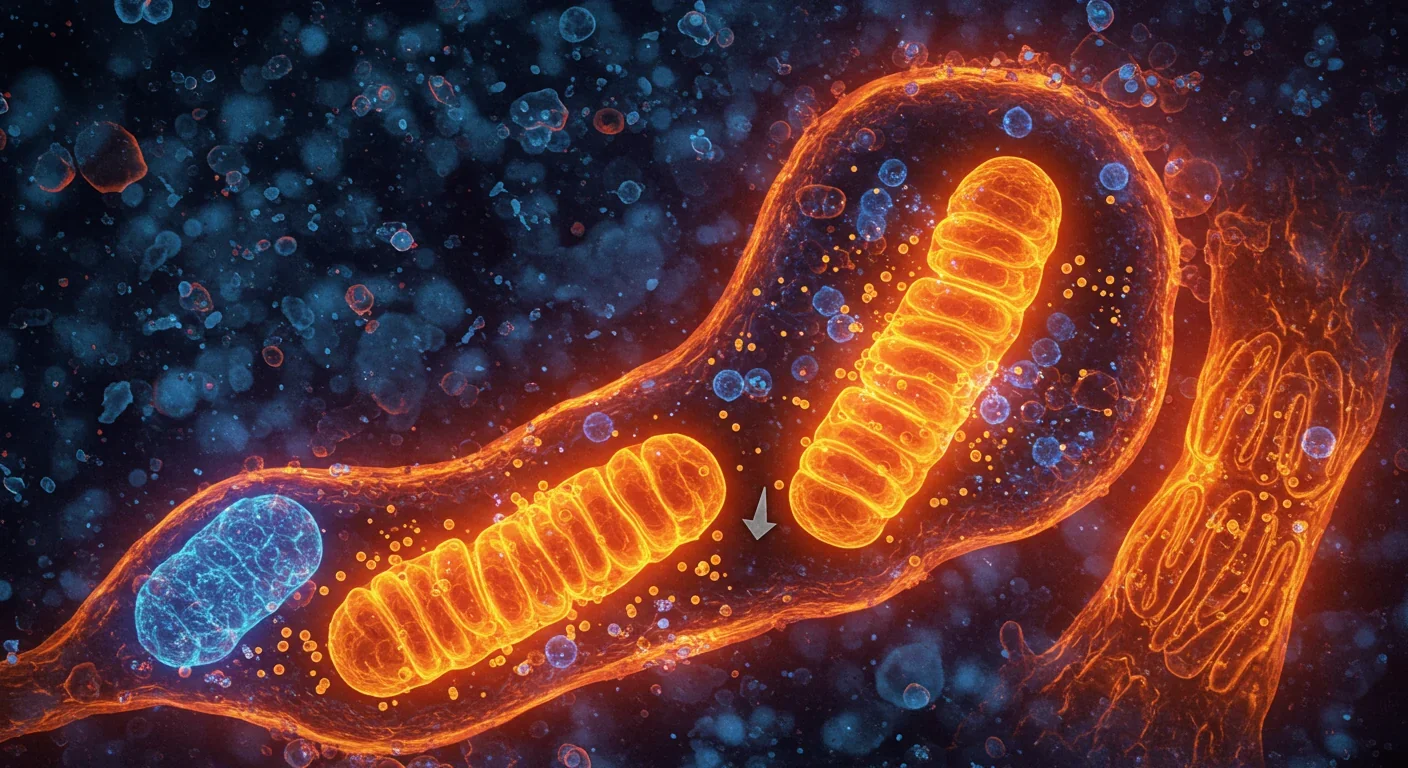
Mitophagy—your cells' cleanup mechanism for damaged mitochondria—holds the key to preventing Parkinson's, Alzheimer's, heart disease, and diabetes. Scientists have discovered you can boost this process through exercise, fasting, and specific compounds like spermidine and urolithin A.

Shifting baseline syndrome explains why each generation accepts environmental degradation as normal—what grandparents mourned, you take for granted. From Atlantic cod populations that crashed by 95% to Arctic ice shrinking by half since 1979, humans normalize loss because we anchor expectations to our childhood experiences. This amnesia weakens conservation policy and sets inadequate recovery targets. But tools exist to reset baselines: historical data, long-term monitoring, indigenous knowle...

Social media has created an 'authenticity paradox' where 5.07 billion users perform carefully curated spontaneity. Algorithms reward strategic vulnerability while psychological pressure to appear authentic causes creator burnout and mental health impacts across all users.

Scientists have decoded how geckos defy gravity using billions of nanoscale hairs that harness van der Waals forces—the same weak molecular attraction that now powers climbing robots on the ISS, medical adhesives for premature infants, and ice-gripping shoe soles. Twenty-five years after proving the mechanism, gecko-inspired technologies are quietly revolutionizing industries from space exploration to cancer therapy, though challenges in durability and scalability remain. The gecko's hierarch...

Cities worldwide are transforming governance through digital platforms, from Seoul's participatory budgeting to Barcelona's open-source legislation tools. While these innovations boost transparency and engagement, they also create new challenges around digital divides, misinformation, and privacy.

Every major AI model was trained on copyrighted text scraped without permission, triggering billion-dollar lawsuits and forcing a reckoning between innovation and creator rights. The future depends on finding balance between transformative AI development and fair compensation for the people whose work fuels it.